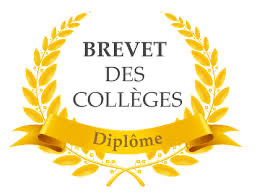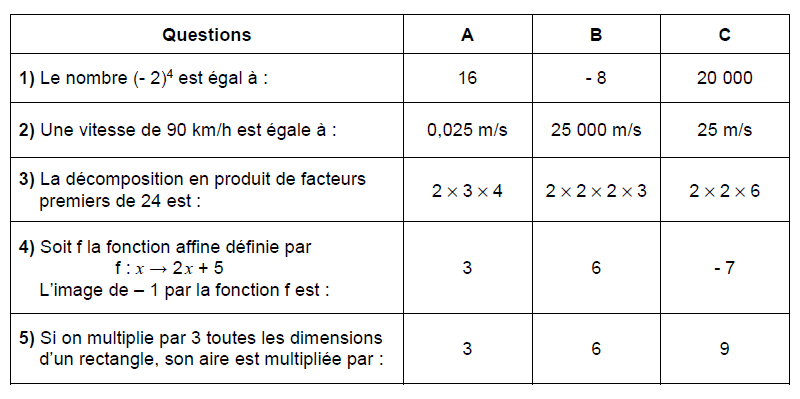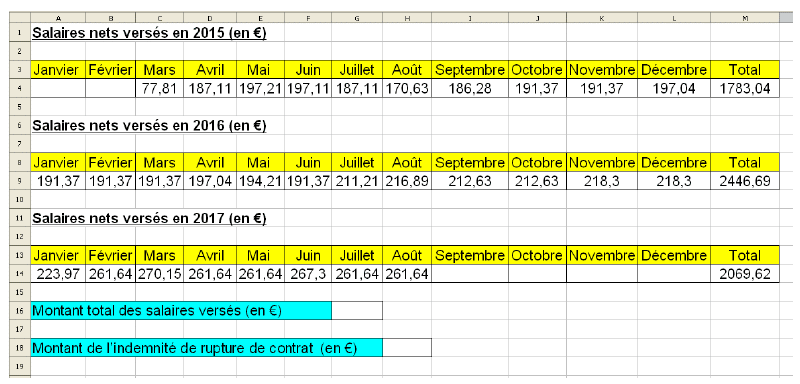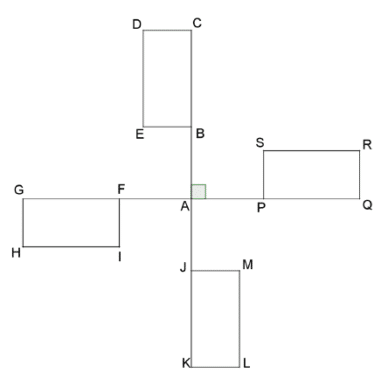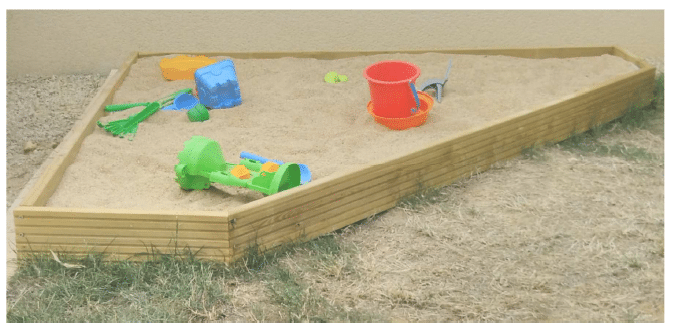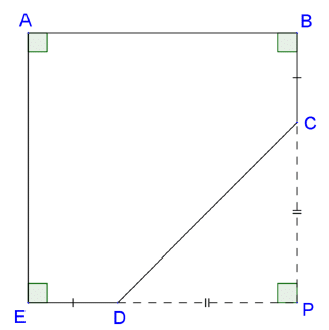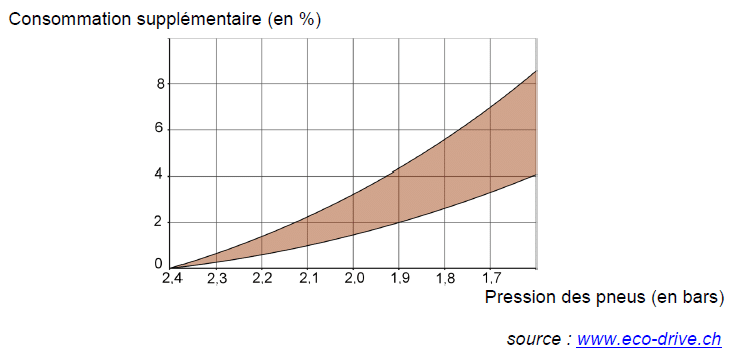MATHEMATIQUES
Série générale – Polynésie Française
Durée de l’épreuve : 2 h 00 100 points
Exercice 1 : (15 points)
Dans ce questionnaire à choix multiples, pour chaque question des réponses sont proposées,
une seule est exacte. Sur la copie, écrire le numéro de la question et recopier la bonne réponse.
Aucune justification n’est attendue.
Exercice 2 : (12 points)
Hugo a téléchargé des titres musicaux sur son téléphone. Il les a classés par genre musical
comme indiqué dans le tableau ci-dessous :
1) Combien de titres a-t-il téléchargés ?
2) Il souhaite utiliser la fonction « lecture aléatoire » de son téléphone qui consiste à choisir
au hasard parmi tous les titres musicaux téléchargés, un titre à diffuser. Tous les titres
sont différents et chaque titre a autant de chances d’être choisi. On s’intéresse au genre
musical du premier titre diffusé.
a) Quelle est la probabilité de l’événement : « Obtenir un titre Pop » ?
b) Quelle est la probabilité de l’événement « Le titre diffusé n’est pas du Rap » ?
c) Un fichier musical audio a une taille d’environ 4 Mo (Mégaoctets). Sur le téléphone
d’Hugo, il reste 1,5 Go (Gigaoctet) disponible. Il souhaite télécharger de nouveaux
titres musicaux. Combien peut-il en télécharger au maximum ?
Rappel : 1 Go = 1 000 Mo
Exercice 3 : (14 points)
Une assistante maternelle gardait plusieurs enfants dont Farida qui est entrée à l’école en
septembre 2017. Ses parents ont alors rompu leur contrat avec cette assistante maternelle. La
loi les oblige à verser une « indemnité de rupture ».
Le montant de cette indemnité est égal au 1/120 ème du total des salaires nets perçus par
l’assistante maternelle pendant toute la durée du contrat.
Ils ont reporté le montant des salaires nets versés, de mars 2015 à août 2017, dans un tableur
comme ci-dessous :
1) a) Que représente la valeur 1783,04 dans la cellule M4 ?
b) Quelle formule a-t-on écrit dans la cellule M4 pour obtenir cette valeur ?
c) Dans quelle cellule doit-on écrire la formule = M4 + M9 + M14 ?
2) Déterminer le montant de « l’indemnité de rupture ». Arrondir au centime d’euro près.
3) Déterminer le salaire moyen net mensuel versé à cette assistante maternelle sur toute
la durée du contrat de la famille de Farida. Arrondir au centime d’euro près.
4) Calculer l’étendue des salaires versés.
Exercice 4 : (14 points)
On s’intéresse aux ailes d’un moulin à vent
décoratif de jardin. Elles sont représentées
par la figure ci-contre :
On donne :
· BCDE, FGHI, JKLM et PQRS sont
des rectangles superposables.
· C, B, A, J, K d’une part et
G, F, A, P, Q d’autre part sont alignés.
· AB = AF = AJ = AP
1) Quelle transformation permet de passer du rectangle FGHI au rectangle PQRS ?
2) Quelle est l’image du rectangle FGHI par la rotation de centre A d’angle 90° dans le sens
inverse des aiguilles d’une montre ?
3) Soit V un point de [EB] tel que BV = 4 cm.
On donne :
AB = 10 cm et AC = 30 cm.
Attention la figure n’est pas construite à la taille réelle.
a) Justifier que (DC) et (VB) sont parallèles.
b) Calculer DC.
c) Déterminer la mesure de l’angle . Arrondir au degré près.
Exercice 5 : (16 points)
On a construit un bac à sable pour enfants.
Ce bac a la forme d’un prisme droit de hauteur 15 cm. La base de ce prisme droit est représentée
par le polygone ABCDE ci-dessous :
Attention la figure n’est pas construite à la taille réelle.
On donne :
· PC = PD = 1,30 m
· ED = BC = 40 cm
· E, D, P sont alignés
· B, C, P sont alignés
1) Calculer CD. Arrondir au centimètre près.
2) Justifier que le quadrilatère ABPE est un carré.
3) En déduire le périmètre du polygone ABCDE. Arrondir au centimètre près.
4) On a construit le tour du bac à sable avec des planches en bois de longueur 2,40 m et
de hauteur 15 cm chacune. De combien de planches a-t-on eu besoin ?
5) Calculer, en m², l’aire du polygone ABCDE.
6) A-t-on eu besoin de plus de 300 L de sable pour remplir complètement le bac ?
Rappel : Volume d’un prisme droit = aire de la basex hauteur
Exercice 6 : (15 points)
L’éco-conduite est un comportement de conduite plus responsable permettant de :
· réduire ses dépenses : moins de consommation de carburant et un coût d’entretien du
véhicule réduit ;
· limiter les émissions de gaz à effet de serre ;
· réduire le risque d’accident de 10 à 15 % en moyenne.
1) Un des grands principes est de vérifier la pression des pneus de son véhicule. On considère
des pneus dont la pression recommandée par le constructeur est de 2,4 bars.
a) Sachant qu’un pneu perd environ 0,1 bar par mois, en combien de mois la pression des
pneus sera descendue à 1,9 bar, s’il n’y a eu aucun gonflage ?
b) Le graphique ci-dessous donne un pourcentage approximatif de consommation
supplémentaire de carburant en fonction de la pression des pneus (zone grisée) :
D’après le graphique, pour des pneus gonflés à 1,9 bars alors que la pression
recommandée est de 2,4 bars, donner un encadrement approximatif du pourcentage de la
consommation supplémentaire de carburant.
2) Paul a remarqué que lorsque les pneus étaient correctement gonflés, sa voiture consommait
en moyenne 6 L aux 100 km. Il décide de s’inscrire à un stage d’éco-conduite afin de diminuer
sa consommation de carburant et donc l’émission de CO2. En adoptant les principes de l’écoconduite,
un conducteur peut diminuer sa consommation de carburant d’environ 15 %. Il
souhaite, à l’issue du stage, atteindre cet objectif.
a) Quelle sera alors la consommation moyenne de la voiture de Paul ?
b) Sachant qu’il effectue environ 20 000 km en une année, combien de litres de carburant
peut-il espérer économiser ?
c) Sa voiture roule à l’essence sans plomb. Le prix moyen est 1,35 €/L. Quel serait alors
le montant de l’économie réalisée sur une année ?
d) Ce stage lui a coûté 200 €. Au bout d’un an peut-il espérer amortir cette dépense ?
Exercice 7 : (14 points)
On donne le programme ci-dessous où on considère 2 lutins. Pour chaque lutin, on a écrit un
script correspondant à un programme de calcul différent.
1) Vérifier que si on saisit 7 comme nombre, le lutin n°1 affiche comme résultat 17 et le lutin
n°2 affiche 41.
2) Quel résultat affiche le lutin n° 2 si on saisit le nombre – 4 ?
3) a) Si on appelle le nombre saisi, écrire en fonction de
.
b) Montrer que cette expression peut s’écrire .
4) Célia affirme que plusieurs instructions dans le script
du lutin n°1 peuvent être supprimées et remplacées par celle ci-dessous.

Indiquer, sur la copie, les numéros des instructions qui sont alors inutiles.
5) Paul a saisi un nombre pour lequel les lutins n°1 et n°2 affichent le même résultat. Quel
est ce nombre ? les expressions qui traduisent
le programme de calcul du lutin n°1, à chaque étape (instructions 3 à 5).
Télécharger et imprimer ce document en PDF gratuitement :
Vous avez la possibilité de télécharger puis d'imprimer gratuitement ce document «brevet Polynésie (septembre 2019 ) session de rattrapage» au format PDF.
D'autres cours et exercices à consulter
- Brevet de maths 2021 : sujet blanc pour réviser
- France 2017 : sujet du brevet de maths avec son corrigé
- Brevet de maths 2024 blanc n° 3 : sujet et corrigé en PDF.
- Brevet de maths 2019 : sujet blanc pour réviser le DNB 2019
- France : Brevet de maths 2024 avec sujet et corrigé en PDF
- Brevet de maths 2016 : sujet blanc
- Brevet de maths 2022 : sujet blanc corrigé du DNB 2022.
- Brevet de maths 2024 blanc n° 2 : sujet et corrigé en PDF.

